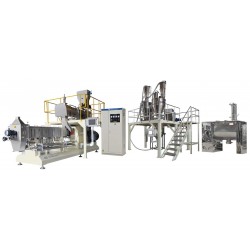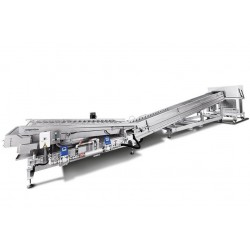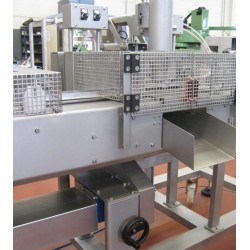Extruders
Extruders are the main piece of equipment in processes that produce foodstuffs through extrusion. In the food industry, these machines are used to produce semi-finished products or ready ones by combining mechanical and thermal processing of the ingredients.
Food extrusion
Food extrusion is the technological process by which soft mixed ingredients, which are heated during processing and thus obtain additional volume, are forcibly pushed through shaped holes in a perforated plate (a die) at a given speed in order to give the product mass a certain shape.
In a subsequent step, the extruded products are cut to the necessary size using special blades.
A food extruder most often consists of a large rotating screw that fits tightly inside a stationary cylinder with a special head at the end. The mixture (extrudate) is passed through this special head.
Synonyms: extruder machine, cereal extruder, feed extruder, food extruder, screw extruder, piston extruder, disc extruder, single-screw machine, molding machine.
Extruded products
Extruders are used in the making of various foodstuffs, usually ones with a high starch content. This is, first of all, all types of cereals.
Foodstuffs that are products of extrusion have a porous or fibrous structure, which depends on the ratio of starch and protein within the batch.
Among the most common extruded foodstuffs are:
- sticks and flakes from various cereals;
- crunchy snacks and sticks;
- dry, shaped breakfast cereals;
- instant porridge;
- baby food;
- potato chips;
- cereal sprinklers (for ice-cream and confectionary);
- bran food;
- breading and breadmaking byproducts
- grain-based snacks
- soy concentrate and piecewise foodstuffs
- compound feed for animals;
- dry feed for animals;
- all kinds of pellets.
What a food extruder consists of:
The main technological units in an extruder are:
- the body of the extruder with a heating system;
- a moving body, i.e. a screw, disk, or piston;
- a loading unit;
- an electric drive;
- controls and indicators so that the machine’s work can be adjusted.
Parts common to all extrusion presses are:
- the plate or die, i.e. the molding and forming element that determines what the discharged product will look like;
- a force pump which creates the pressure needed to move the mass through the openings in the die.
The production process
During extrusion, the input material is first ground until it reaches the desired size. Additional ingredients are added to the dry mix according to the product recipe. This could be simply water, sugar syrup, oils, food colorings, or even meat.
The mass held in the loading unit is then moved through the body of the machine by means of the screw. Here the mass passes through several stages: mixing, melting and forming the shape for the product.
The technology for producing starch- and protein-containing products is based on the combined effect of humidity, temperature and rapidly changing pressure.
Single-screw or multi-screw machines are designed for warm or hot processes of extrusion:
During warm extrusion, dry ingredients are mixed with water in the required ratio, and then the input materials are subjected to mechanical and heat treatment. Due to this heating of the input materials, the extrudate exhibits elasticity, brittleness, and a slight increase in size.
During the process of hot extrusion, the input material takes on a given shape due to high rotation speed, high temperature, and high pressure.
Products by type of extrusion:
|
Extrusion methods |
|
|
Warm |
Hot |
|
crackers, breakfast cereals, some types of pasta, cereal-based snack bites |
dry breakfast foods, corn puffs, beverages in powder form, soups, meat products |
Equipment classification
Three basic types of extruders are used in the food industry:
- piston type;
- screw type;
- disc type.
Screw-type machines in turn may consist of various numbers of screws.
Normal and high-speed screw-type machines differ based on how fast the screw moves, and on whether they are of stationary or rotating design, and also based on whether the screw is positioned along the body of the machine or across it.
Screw-based extruders
The most common machines are those that use screws that turn in a single direction after a hook. Also used are devices with parts that perform not only rotation but also back and forth motions.
To ensure maximum mixing, auxiliary elements like splines or teeth can be installed.
Single-screw extruders
Devices of this type are used in producing compound feed for animals and simple products such as corn flakes or puffs.
The drawback of using a single-screw press is the need to determine the initial moisture level of the input material, because this value determines the quality of the final product and has a direct impact on the process. For example, when producing compound feed, the moisture level of the wheat should be within the range 18–20%. To ensure that this value is reached, the input materials are pre-soaked.
If the product is unevenly discharged from a single-screw machine, this can have a negative impact on the consistency of the final product in terms of size and shape. So, the equipment operator needs to constantly monitor the extrudate at the output and take into account the specific properties of the input materials.
The lack of the ability to change the screw rotation speed means lower performance, but the great simplicity of these designs has led to their wide use in industry.
Twin-screw extruders
This type of equipment is used for producing a very wide range of foodstuffs. Especially popular are a variety of corn-based products (balls, rings, stars, and other shapes), baby food, breadcrumbs, and feed for animals and fish. These machines ensure that a screw is launched promptly and they operate at high speed, which helps to ensure a more thorough mixing of the ingredients by means of two screws.
The liquid components continually flow within the body of the machine. The controlled feeding of ingredients eliminates the need to consider the initial moisture value, and it allows you to determine the properties and quality of the resulting extrudate. After the operating parameters have been set, the line operates virtually on its own, and the temperature values for heating the body of the machine are automatically maintained.
Twin-screw machines produce expanded and cold-extruded products by replacing the set of screws.
Die types
The configuration of holes in the head are what determine the appearance of the product. For whole products the die can be:
- round;
- rectangular;
- square.
Sections of complex shape with inserts are used for producing hollow products.
The structure of the extrudate depends on the design of the plate (die):
- porous;
- fibrous;
- whole.
Products with a fibrous and homogeneous structure are obtained by using longer dies with a gradual decrease in the temperature of the melted substance and pressure.
For producing extrudates with a porous structure, short dies are used without any cooling step. The abrupt drop in pressure and temperature at the outlet leads to the instantaneous evaporation of moisture, which causes pores to appear in the structure of the product.
Force pump types
The force pump in the machine can be periodic or continuous action.
The most common alternating pumps are screw and piston types, which are used in the hydroextrusion process.
Continuous-action force pumps:
- screw type;
- roller type;
- gear type.
The choice of which force pump to use depends on the initial properties of the mass to be extruded and its molding and shaping requirements.
Piston and roller devices exert a gentle pressure on the input materials, so they are most suitable for preparing products with a delicate texture.
Gear-type machines are used for homogeneous products. Because their action is not stable, they are not recommended for input materials with solid components that could be destroyed.
In industry, extruders are also called forming and shaping equipment that works according to the principle of extrusion.
These machines can be used successfully not only with dry products but also moist ones, for example, when producing crab or fish sticks. Many candy pieces and bars are made according to the same principle.
For more on these devices and how forming machines work, see here.

 English
English
 Deutsch
Deutsch
 Français
Français
 Español
Español
 Italiano
Italiano
 Português PT
Português PT
 Русский
Русский











